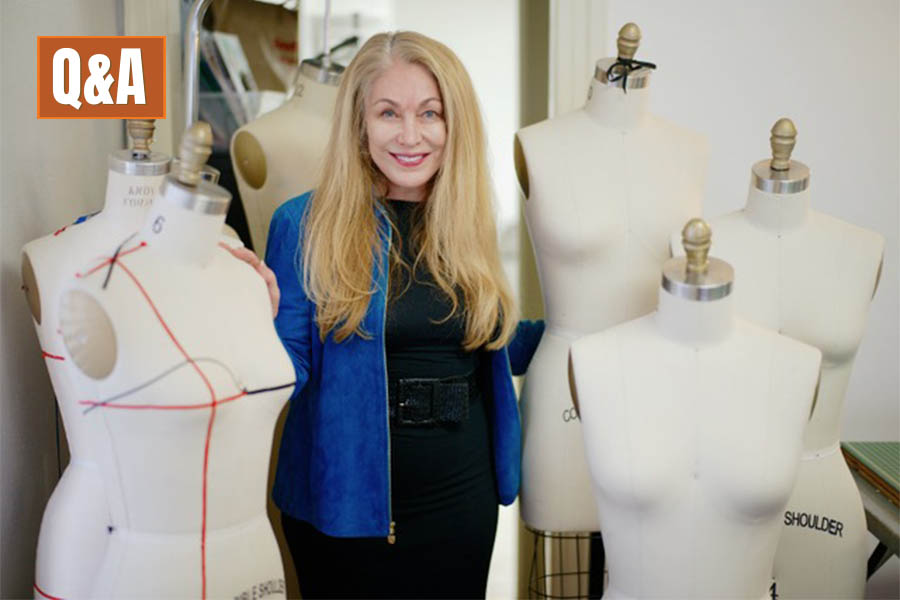Courtesy of Portland Fashion Institute
The PFI started as a series of sewing and patternmaking classes in Portland’s Hollywood neighborhood. Now more than 8,000 students have taken classes at the school — and many go on to full-time careers in the apparel industry.
When Sharon Blair was four years old, her aunt Marilyn offered to make a dress for one of her dolls. But Blair wasn’t content to just accept the gift; she wanted to get involved.
“I forced her to allow me to sit on her lap, because no, I didn’t want her to make it for me. I wanted to make it for myself. Thank you very much,” Blair says.
Blair, who is originally from Muncie, Indiana, went on to study couture, patternmaking and tailoring at the Paris American Academy. She moved to Portland in 1982, pulled by the growing apparel industry — she notes that largely due to Nike, Portland has the third largest apparel industry, behind New York and L.A. Told by family members that she could never make a living in fashion full-time, Blair pursued a career in public relations, but also ran fashion businesses on the side. She started teaching sewing and patternmaking classes, at first for Palmer/Pletsch — a Vancouver-based company that publishes books and offers workshops on sewing and patternmaking — and later for the Art Institute of Portland.
In 2008, Blair began teaching classes under the business name Portland Sewing, which in 2010 became the Portland Fashion Institute. The Institute has since received accreditation through the Accrediting Council for Continuing Education and Training (ACCET), making it the only private, nonprofit accredited fashion design program in the state of Oregon, according to Blair. The school has also taught more than 8,000 students. Some, Blair says, take a class or two, either as a hobby or as continuing education for those who work in the fashion industry and some go through a full program that takes between a year and a half to three years to complete. The total cost of the program is $22,000, and Blair says the school works with students to find ways to ensure they graduate without debt, to ensure they not only go onto lucrative careers but aren’t stuck with student loan payments for years to come. Currently the school has 627 students.
PFI also hosts community events, including an upcoming fashion show for graduates and quarterly fashion seminars. The next, on June 29, will feature Amanda Needham, a Portland-based designer whose work has been featured in a variety of Portland-filmed movies and TV shows, including “Shrill,” “Portlandia” and Wendy and Lucy.
Blair spoke with Oregon Business about PFI’s model and students, where the fashion industry is headed — and a surprising possibility for artificial intelligence in the industry.
This interview has been edited for space and clarity.
When you started out, you were just teaching some basic sewing and patternmaking classes, and then started to expand. What did that expansion look like?
We started adding more apparel classes, particularly in the proper way to construct garments, having worked in the industry — as well as having studied in Paris, — we saw how commercial patterns were leading people astray, and making them frustrated with the whole creation process. So we decided that, what the heck, let’s just teach them the way it’s done in the apparel industry. It’s a very scientific method of how to approach design and creation of apparel products. We still teach it today, and I think that’s what has attracted people to us and kept them happy.
Tell me a little bit more about what that process is like, and how it differs from commercial pattern making.
Do you do sew at all?
I do a little bit, yeah.
So you know that [commercial patterns] always have you putting in pins. In the industry, we never use pins. We trust our cut. We use drawings to show how to line up the raw edges and we use our fingers. Our fingers are pivots. So that’s among the most basic of things is how to sew properly. It’s a lot faster, and you’re going to get speedier and more confident results every time when you trust your cut and use your fingers for sewing rather than pins or clips.
Who are most of your students? Are they right out of high school, or pursuing second careers?
Our basic demographic — and it’s remained true throughout the years — is 25 to 35. These are folks who, probably much like me, had parents who said, “You’re not going to be able to make a living in the fashion business.” They are phlebotomists, they are paralegals, they are physicians, they are engineers at Intel. They have decided they want to use their right brain, they want to be creative, so they have jumped into exploring apparel design. I think a lot of folks forget that there’s this whole place over the West side called Nike, and it’s Oregon’s only Fortune 500 company. They employ a lot of people and people do very well there.
It’s a requirement that teachers who teach at PFI are working currently in apparel. We have a lot of our teachers who have a day job at Nike, and then they’re so kind as to come and teach for us in the evenings or the weekends. We have board members from Adidas, Columbia Sportswear, Nike, Pine Crest fabrics, VF Corporation, the North Face and the former president of PNCA, who helped sculpt our curriculum. We have helped grow this curriculum and giving people whether it is the design classes, or the technical development classes, or the business classes they need to meet their needs and grow.
We are getting more students right out of high school. We just did a gig at Grant High School teaching high school students. We’ll likely get more high school students, because of that. These kids really made me feel very hopeful.
It seems like a lot of your students go on to work for local companies, and certainly the local industry is mostly sportswear or athleisure. What are some of the trends that you see in that industry? I mean, we know that Nike is contracting a little bit, but what what’s happening broadly?
I think that people are still working in athleisure. Look at us here: We are having our meeting from home. That’s the way of the workplace now, even though companies, including Nike, are encouraging people to come back to the office. It’s always good to look like you are ready to work out, even if you’re not. And we’re looking to be comfortable in our work environment, or we’re looking to be comfortable in our bodies. We’re looking to be comfortable in our lifestyle. And when people dress up these days, their idea of dressing up is wearing jeans — whether it’s going to Portland Opera, or the gala at the Portland Art Museum. It’s like the Portland standard of dressing, a T-shirt and jeans.
I would be remiss if I didn’t point out that sustainability is so big these days — circularity and sustainability and zero waste. I don’t care if you’re the head of innovation at Nike, or you’re one of the students I just coached at Grant High School, that’s very much on people’s minds — avoiding the landfill. How can we reuse this fabric? How can we make this fabric more long lasting, more responsive to people’s lives, like using AI Artificial Intelligence to help with our supply chain, clear on up through designing and finished garment.
Here’s where we could turn AI into our friend instead of our feared enemy. Now with computer patternmaking, people can take the measurements of their target customer, and they’ll turn that into an avatar. They can take a design, turn it into a pattern, fit that onto the avatar and check the fit. From that, they will see if they can get orders and then make that size run. You’re not sending prototypes back and forth to China and doing three to 35 fitting sessions to get to the garment. You can put that on social media to see if people want that, and get orders before you make a bunch that no one buys it and it goes into the landfill. So sustainability is a big trend.
It seems like two different things happening at once. There are brands like Shein that are just completely out of control with how cheap and nearly disposable they are. Then this other trend towards maybe spending a little bit more for something that you’re not going to have to throw out after two wears.
I hear you. I mean, everybody wants a bargain, don’t they? That’s why they still shop at H & M and Zara and Forever 21. It’s always going to be there, even among the young folks who espouse going to the vintage store and reworking throwaway garments. We’ll see how that all plays out.
You mentioned that a lot of your students are part-timers who maybe already have jobs in fashion. Where do people tend to end up? Do they tend to stay local? Do they go to companies elsewhere?
Our grads have gone all over. We draw students from all across Oregon, and quite a few of them are going back to their hometowns and trying to make a company or living or boutique there. We have people coming from and going back to places like Pendleton, Hood River, Roseburg, Seaside, Tillamook. It’s true that we have such a large draw here in town. But I will also tell you that people have gone to take jobs in Denver, San Francisco, Los Angeles, New York (of course), Wisconsin, Eugene, where Browzwear, the 3D patternmaking company is based. I’ve actually had students get jobs and move to London.
Click here to subscribe to Oregon Business.



